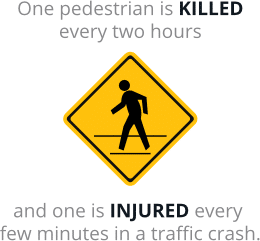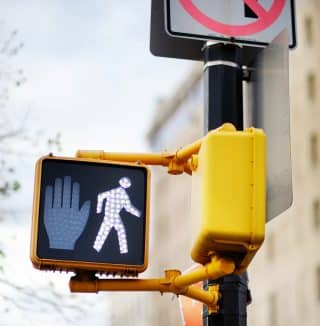Walking in America is becoming more dangerous every day. In what it called the “largest annual increase ever recorded,” the Governors Highway Safety Association (GHSA) estimated an 11% rise in pedestrian deaths from 2015 to 2016. The rate topped a 9% increase from the previous year. (1) Based on reports from state highway safety offices from all 50 states and the District of Columbia, the GHSA estimated 5,997 people were killed while walking or standing along highways and streets in 2016. (2) Tens of thousands more are injured annually. (3)
Driver Negligence Can Seriously Injure Pedestrians
Highway safety professionals refer to the impact between a motor vehicle and a pedestrian as a crash rather than an accident. The Federal Highway Administration (FHWA) makes this distinction because “crashes are preventable.” (4)
The New York City Department of Transportation (NYCDOT) found that, in 2009, “driver inattention was cited in nearly 36% of crashes resulting” in death or serious injury to a pedestrian.”
Driver negligence is a frequent contributing factor to crashes in which a pedestrian is injured or killed. The New York City Department of Transportation (NYCDOT) found that, in 2009, “driver inattention was cited in nearly 36% of crashes resulting” in death or serious injury to a pedestrian. The failure of a driver to yield to pedestrians was cited in 27% of fatal pedestrian crashes. (5)
The National Highway Traffic Safety Administration (NHTSA) found that, in 2014, pedestrians accounted for more than half of all traffic fatalities in four major U.S. cities: New York, Boston, San Francisco, and Albuquerque, New Mexico. (6) Nationally, the rate was just 15%. (7)
If you’ve been injured by a driver’s negligence, you may benefit from talking with an attorney. Weitz & Luxenberg’s Personal Injury and Malpractice unit has decades of experience in seeking justice for people harmed in crashes in which pedestrians were the victims.
Were you or a loved one seriously injured after being hit by a car? Contact us now for a free consultation.
Get a Free Case ReviewMotor Vehicle Crashes Injure Thousands of Pedestrians Every Year

By the CDC’s estimates, one pedestrian is killed every two hours and one injured every few minutes in a traffic crash. (8)
The NHTSA estimated 65,000 pedestrians were injured in motor vehicle crashes in 2014, (9) but the number may be much higher. The NHTSA figures rely on police reports of crashes. (10) But a study of emergency room patients found more than half of pedestrian injuries happened on private property, such as parking lots, where a police report may not have been taken. (11)
A search of the CDC’s WISQARSTM (Web-based Injury Statistics Query and Reporting System) database found 189,581 people treated in hospital emergency rooms for pedestrian crash injuries in 2014. (12)
Why Did Pedestrian Injuries from Motor Vehicles Rise?
Between 2005 and 2013, nearly a million more people reported walking or biking to work. (13) Although more people are walking, people are also driving more miles — 50.5 billion miles in the first half of 2016. (14) This combines for a greater likelihood of motor vehicles and pedestrians literally crossing paths.

Most Common Pedestrian Injuries from Motor Vehicle Crashes
The speed of a vehicle can play a major role in the severity of injuries in a crash with a pedestrian. While 95% of pedestrians will survive a collision with a vehicle traveling 20 mph or slower, survivability falls to 60% if the car is traveling 30 miles per hour. (15) But even at low speeds, the human body is no match for a car, truck, or bus.

The most common injuries to pedestrians from motor vehicle crashes include: (16)
- Head trauma, including traumatic brain injury (TBI)
- Neck injuries
- Leg and hip trauma
- Bone fractures
- Ligament and knee injuries
How to Protect Yourself Against a Motor Vehicle Injury When Walking
The most severe motor vehicle crashes with pedestrians tend to happen in urban areas, away from intersections, or while it is dark. (17) Knowing this can help you take steps to protect yourself.
Safety measures include: (18)
- Crossing streets at crosswalks or intersections whenever possible
- Increasing your visibility at night by carrying a flashlight and wearing reflective clothing
- Walking on a sidewalk, or, if one is not available, walking on the shoulder and facing traffic
- Avoiding electronic devices or other distractions that divert your attention from the road
No matter what precautions you take, you cannot always protect yourself from a negligent driver. Common contributing factors on the part of a driver involved in a crash with a pedestrian include: (19)
- Impaired driving due to alcohol or drugs
- Distracted driving
- Speeding or reckless driving
- Sign or signal violation by the driver
- Hit and run
Texting and Cell Phone Use Causing Distracted Driving
Texting and other cell phone use while driving are two examples of distracted driving on the rise. In fact, according to the Federal Communications Commission (FCC), “At any given daylight moment across” the United States, roughly “660,000 drivers are using cell phones” or are distracted by other electronic devices while they are driving. (20)
Compared to other forms of distracted driving, such as eating, texting and other cell phone use are particularly dangerous according to the Centers for Disease Control and Prevention (CDC).
The reason: these activities combine “all three types of [driver] distraction”: (21)
Visual
Taking your eyes off the road
Manual
Taking your hands off the steering wheel
Cognitive
Taking your mind off driving (22)
In essence, according to the NHTSA, “Texting is the most alarming distraction. Sending or reading a text takes your eyes off the road for 5 seconds. At 55 mph, that’s like driving the length of an entire football field with your eyes closed.” (23)
With thousands of deaths attributed to distracted driving each year, (24) more and more states are legislating texting and other cell phone usage bans. (25) For those harmed by distracted drivers, these laws may work in your favor.
Weitz & Luxenberg Can Help
Nicholas Wise, senior trial attorney with Weitz & Luxenberg’s Personal Injury and Malpractice unit, is committed to “the strongest, most aggressive representation possible.”
When a 79-year-old Holocaust survivor was struck and killed by a New York Metropolitan Transportation Authority (MTA) bus making a left turn, her family turned to Weitz & Luxenberg for help. Mr. Wise secured a $1.5 million settlement from the MTA for the family.
“At the end of the day, this is about being a champion for those injured by others’ negligence,” Mr. Wise said.
“As attorneys we can’t undo acts of negligence,” Mr. Wise said at the time. “The best we can do is help survivors seek justice for their loved ones. Such a tragedy could have been avoided had the bus driver simply observed proper driving safety precautions.”
In another case, Mr. Wise secured an $800,000 settlement for a woman struck by a passing car as she stepped off a bus. The crash broke the woman’s ribs and pelvis, requiring surgery.
In one of the most disturbing cases in recent years, a passenger in one vehicle was left paralyzed from his mid-chest down when the vehicle in which he was traveling was struck by a driver who had run a stop sign and then fled the scene. What makes this case particularly reprehensible is that the driver of that vehicle and his father concocted a story to avoid taking responsibility for the plaintiff’s injuries.
Learning that his son had been involved in an accident, the father reported that the car had been stolen recently. Both father and son not only lied to police, but also lied in their testimony on the stand to avoid being held accountable.
Once again, Weitz & Luxenberg’s Nicholas Wise, along with Adam Raffo, a Weitz & Luxenberg associate attorney in the firm’s Personal Injury and Malpractice unit, made it abundantly clear to jurors that this testimony was an elaborate cover-up.
The result: Mr. Wise and Mr. Raffo secured a phenomenal $20.5 million dollar verdict in favor of their client, who will need to use a wheelchair for the rest of his life. The firm’s attorneys also achieved an award of $3 million for their client’s past and future medical expenses.
This exceptional win earned Weitz & Luxenberg a coveted #1 verdict spot in the New York Law Journal’s Top Verdicts and Settlements for 2016, placing number 1 in the category of Motor Vehicles and number 4 overall.
